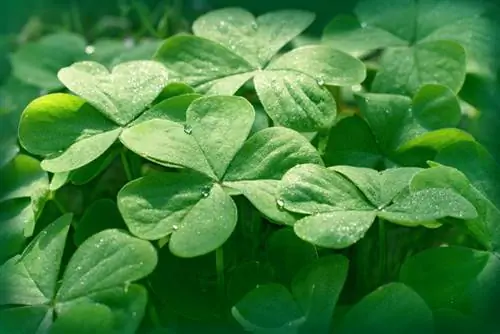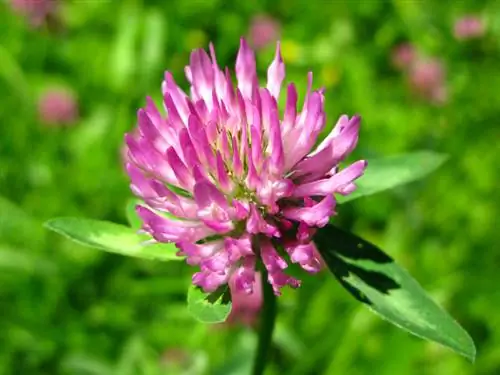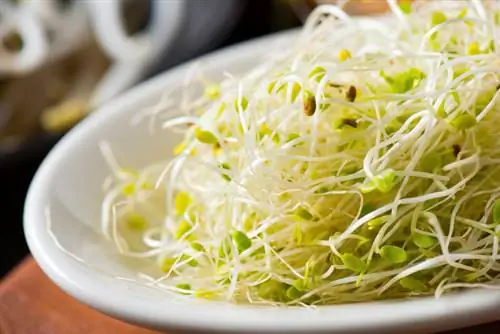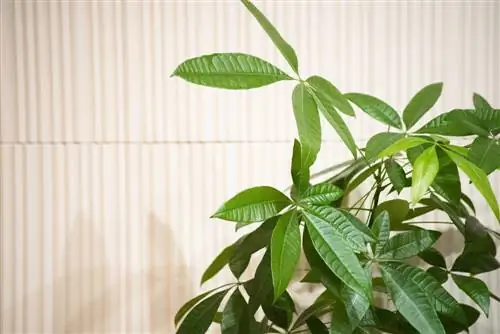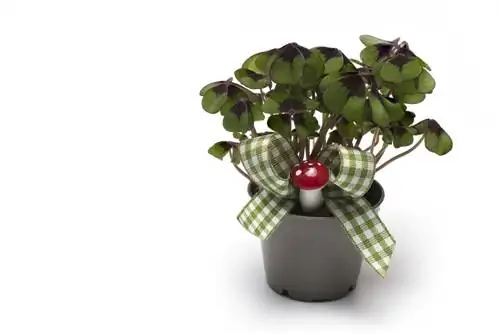- Author admin [email protected].
- Public 2023-12-16 16:46.
- Last modified 2025-01-23 11:22.
Lucky clover is said to bring good times to the recipient. But in contrast to the real four-leaf clover from the meadow, the lucky clover is a dime a dozen. Anyone who finds the special leaf in nature can count themselves really lucky.

How rare is a four-leaf clover?
The chance of finding a four-leaf clover is about 1:5000. They occur more frequently in white clover (Trifolium repens) and can be found in nutrient-rich, moist locations such as meadows and pastures. Four-leaf clovers are considered symbols of good luck and are important in Christian symbolism.
Symbol of happiness
The four-leaf clover has a special meaning in Christian symbolism. Here it embodies the cross and the four gospels. The fact that the leaf is associated with luck is not only due to its rarity. The symbolism probably goes back to the strong and vital growth of the plants. The superstition has persisted to this day, so that the four-leaf clover is a popular template for tattoos, sayings and drawings.
Myths about the 4-leaf clover:
- Eve took a leaf with her when she was expelled from paradise
- Celtic druids use them as a means against evil spirits
- English writer John Melton is probably the first to mention the shamrock as a symbol of good luck
Why do some leaves have four parts?
It is not yet clear whether the phenomenon has a genetic or environmental cause. Researchers at the University of Georgia have discovered a rare gene that turns the three-leaf clover into a four-leaf clover. They suspect that leaf development is strongly influenced by environmental factors. Various triggers may be responsible for the mutation. It could also be that the interaction of several genes is responsible for the malformation.
How rare are four-leaf clovers?
The chances of finding a four-leaf clover are extremely slim. There are currently no scientific studies on the frequency. Collectors report different rates. Two Bernese cloverleaf enthusiasts conducted their own study in 2017. They searched in 35 locations in six different European countries. According to their findings, there is one four-leaf clover for every 5,000 three-leaf clovers. This means they have doubled the find rate, which was previously estimated at 1:10,000. During their recordings, the two also found plants with six to eight-part leaves.
Search instructions
If you want to find a four-leaf clover, you need to look in the right locations. In principle, you can find little lucky charms everywhere. Once you have found a leaf, there is an increased chance that you will find other malformed leaves nearby.

Finding the right clover
Most four-leaf clovers occur on white clover (Trifolium repens). From a botanical perspective, the supposed four leaves represent only one leaf, which is divided four times. In addition to the typical three leaflets, another leaflet is formed, which is much smaller than the remaining three leaflets.
Not to be confused with:
- Lucky clover (Oxalis tetraphylla)
- Four-leaf clover fern (Marsilea quadrifolia)
Find locations
White clover is widespread throughout Germany and prefers to grow in meadows and pastures. Since the species is extremely resistant to treading, it is often found on roadsides and sports facilities. The plant grows in nutrient-rich and moist soil that is slightly calcareous and clayey. White clover also grows on sandy soils. Although the lucky leaves are mutations, the plants do not necessarily have to grow near busy roads or power plants. Four-leaf clovers can also occur in rural areas.
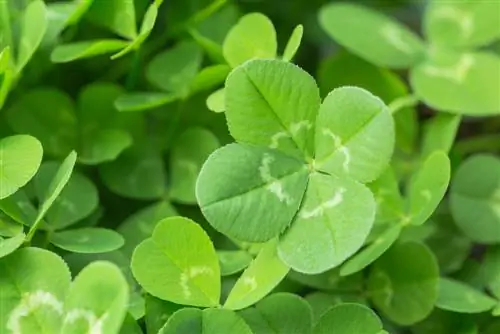
Four-leaf clovers stand out from the sea of three-leaf clovers
Four-leaf clovers can occur anywhere. For the trained eye they are hard to miss.
Excursus
Clover as an all-rounder
Meadows that are full of clover are considered fresh and fertile. This is due to a very specific property of the plant. It lives in a symbiosis with nodule bacteria that bind nitrogen from the air and make it available to plants. In this way, clover increases soil fertility and animal visitors also appreciate it. Because of its high protein content, clover is a popular feed plant for sheep and cattle. Nectar is produced in the long calyxes, which attracts long-pronged insects. Clover is often grown to produce clover honey.
Search area
White clover prefers to grow in the company of other individuals and rarely grows alone. This causes the plants to form extensive carpets that are difficult to examine. There is therefore no point in looking at every single cloverleaf. Focus on a defined area the size of an A3 sheet:
- Sweep the surface in lines with your eyes
- pay attention to leaf symmetry
- look closer if you notice a leaf with three symmetrical leaflets and one smaller leaflet
- continue searching in the surrounding area
Store
Place the collected leaf between newspaper and press it with a heavy book. Change the newspaper daily to prevent the sheet from rotting. When it is completely dry, you can frame it or immortalize it in homemade pendants.
Get clear synthetic resin (€34.00 at Amazon) from the hardware store or use tree resin you collected yourself. Place the leaf in a flexible plastic lid and pour the liquid resin over it. After drying, the pendant can be removed from the lid by bending it slightly. You can then drill a small hole and thread a string for hanging.
Tip
You can also pour liquid and colorless candle wax over the leaf.
Planting and caring for lucky clover
Trade has recognized that the four-leaf clover sells well. Therefore, species with four-part leaves have become established as symbols of good luck in garden centers and hardware stores. There are also varieties of white clover that produce lucky leaves:
- Trifolium repens 'Purpurascens Quadrifolium' with purple leaves
- Trifolium repens ‘Quadrifolium’ with green leaves
- Trifolium repens 'Good Luck' with three to five-part leaves that develop a dark center
The typical clover that you can buy in any supermarket on New Year's Eve is a species from the sorrel family. Four-leaf wood sorrel originally comes from Mexico. Feral populations keep appearing in Europe.
Lucky clover has demands
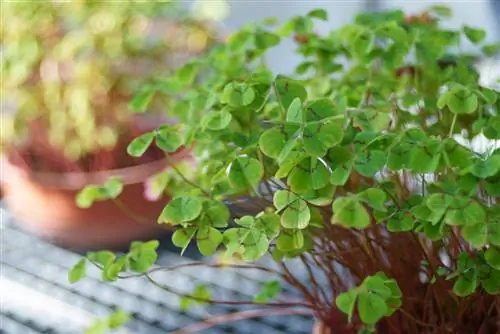
Lucky clover is often used as a potted plant on the windowsill
The plant is given away in small pots as a good luck charm on New Year's Eve. It doesn't last particularly long on the windowsill because it prefers cool temperatures between ten and 15 degrees Celsius and lots of light. You don't get good heating air. The substrate should be humus and well-drained. Mix heavy soil with sand to improve structure. In summer the clover can be planted in the bed. A sheltered spot in partial shade offers ideal conditions. The bulbs are planted about five centimeters deep in the soil.
Tip
If you want to grow the lucky clover yourself, you can dig up the rhizomes in the fall and divide them.
Care and wintering
If you keep in mind that the lucky clover comes from Mexico, caring for it is not very difficult. The plant has a main growth period, which is followed by a winter break. The clover draws energy from the leaves and stores it in small nodules. These are kept dry and frost-free over the winter. If it is watered all year round, the plant will not soak in and will continue to grow.
| How? | Why? | |
|---|---|---|
| Fertilize | between April and August every three weeks | high nutrient consumption in the growth phase |
| Cutting | not at all | needs leaves for nutrient production |
| Pouring | economical | prefers moderately moist soils |
| Repotting | plant in clay soil in March | Roots need space |
Plant description
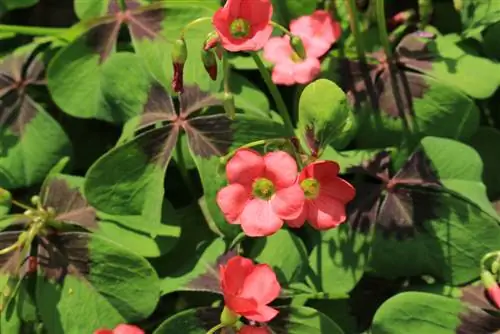
Lucky clover not only has beautiful leaves but also pretty flowers
Oxalis tetraphylla grows as a perennial bulbous plant and reaches heights of 20 centimeters. The shoot axis grows completely underground. Only the leaves emerge from the substrate from April and unfold in daylight. They always align themselves with the sunlight and fold up as soon as the sun goes down. Lucky clover reproduces via underground runners on which breeding nodules are formed. This way it can grow a lot.
- Leaves light green with purple center, slightly hairy
- one to three flowers are on a long stem
- Flowering period extends from April to June
- lucky clover blooms pink
Frequently asked questions
What is the probability of finding a four-leaf clover?
The literature does not agree on how often the malformed leaves occur. Different information is circulating. But two amateur researchers from Switzerland looked at places of growth all over Europe and counted four-leaf clovers. They came to the conclusion that for every 5,000 three-leaf clovers there is one four-leaf clover.
How many leaves can a clover leaf have?
In 2009, the Japanese Shigeo Obara discovered a clover leaf that had 56 small individual leaves. He set a record and was included in the Guinness Book of Records. It is possible that clovers have five to eight leaflets. However, the probability of finding such malformations decreases as the number of leaflets increases.
Where can I find four-leaf clovers?
Basically, you can find a lucky charm wherever clover grows. The mutations are often discovered in white clover. Pay attention to nutrient-rich and not too dry locations such as meadows and pastures. The larger the clover carpets are, the more chances you have of finding one.
Is the lucky clover a special breed?
Behind the lucky clover is a species of the sorrel family that is native to Mexico. It naturally forms four-pinnate leaves, the center of which glows dark purple. Since the four-leaf clover became established as a symbol of good luck, retailers have specialized in selling this plant seasonally. You can find lucky clovers in supermarkets and garden centers, especially on New Year's Eve.


